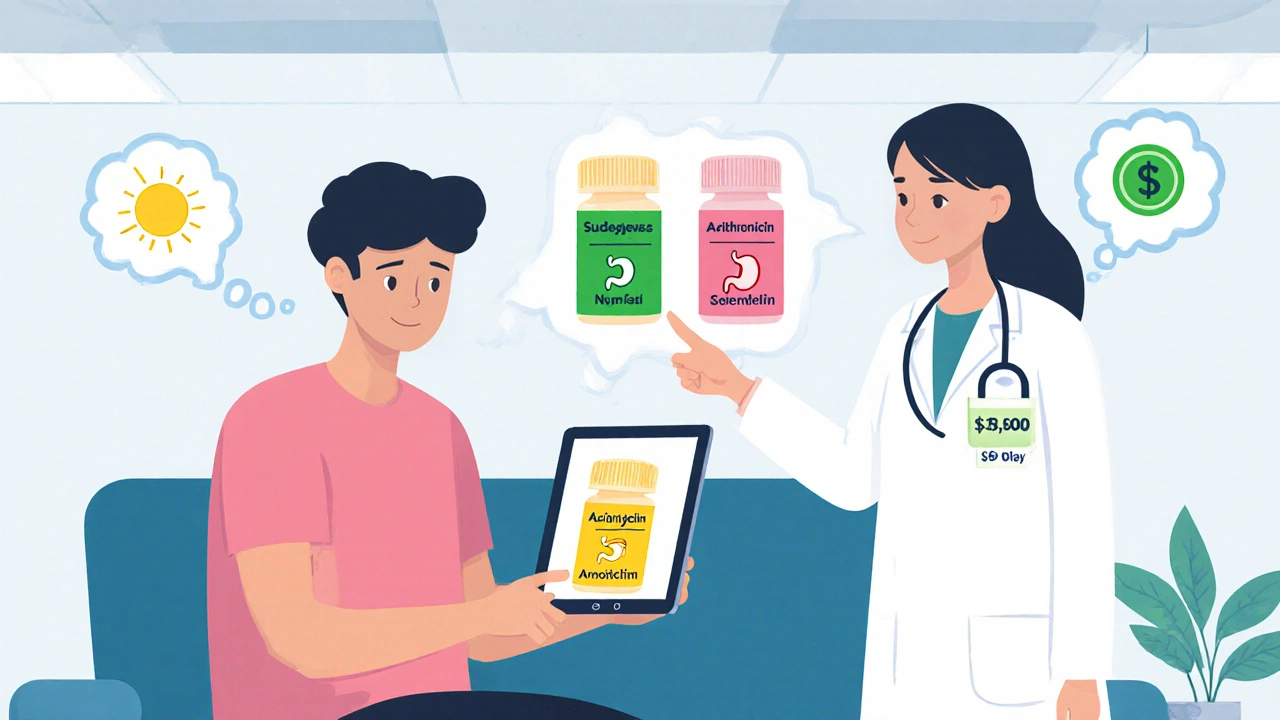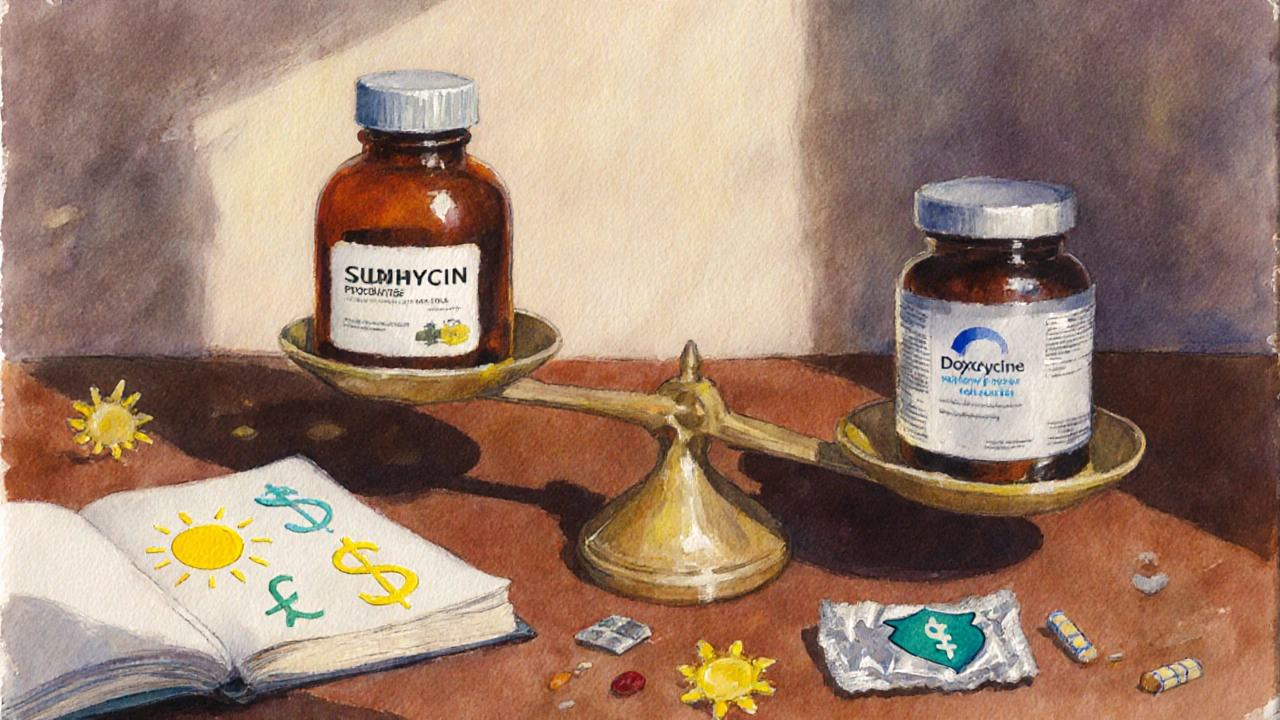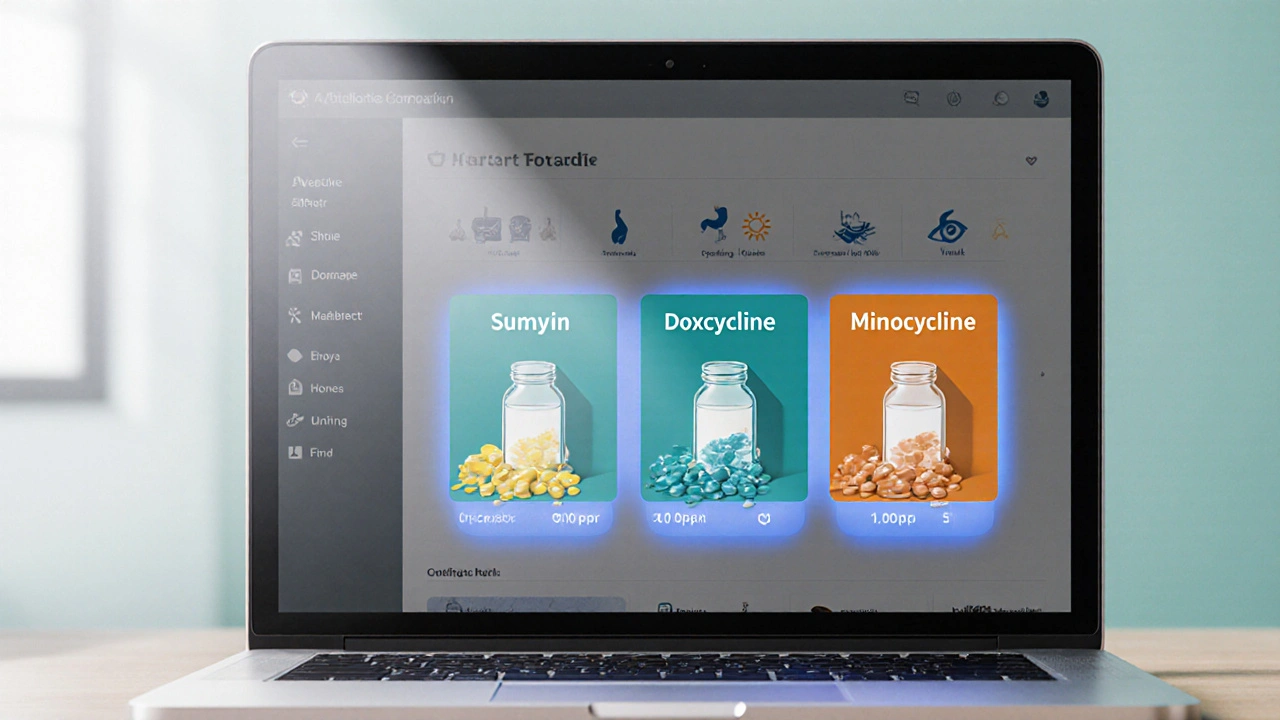Antibiotic Comparison Tool
Indications: Acne, RTIs, UTIs, rickettsial disease
Dosage: 250 mg q6h × 7-14 days
Side Effects:
Nausea Vomiting PhotosensitivityCost: $25
Indications: Lyme disease, acne, travel-related fever
Dosage: 100 mg bid × 7-14 days
Side Effects:
Esophagitis Mild photosensitivityCost: $30
Indications: Severe acne, rosacea
Dosage: 100 mg qd or bid × 4-12 weeks
Side Effects:
Vertigo Hyperpigmentation Lupus-like reactionCost: $35
Indications: Chlamydia, bronchitis, skin infections
Dosage: 500 mg d1 then 250 mg d2-5
Side Effects:
Diarrhea QT prolongationCost: $28
Indications: Sinusitis, otitis media, strep throat
Dosage: 500 mg tid × 5-7 days
Side Effects:
Rash GI upsetCost: $12
Indications: MRSA skin infections, anaerobic abscesses
Dosage: 300 mg q6h × 7-10 days
Side Effects:
C. difficile risk Metallic tasteCost: $40
When choosing an antibiotic: Consider spectrum of activity, pharmacokinetics, side effect profile, resistance patterns, and cost. For example, doxycycline offers better absorption and fewer food interactions than Sumycin, while amoxicillin is ideal for pediatric respiratory infections.
Recommended Antibiotic:
Based on your selections, we recommend:
Quick Take
- Sumycin (tetracycline) is an older broad‑spectrum antibiotic with notable GI upset and photosensitivity.
- Doxycycline and minocycline are newer tetracyclines that offer better absorption and fewer food interactions.
- Azithromycin works for many of the same infections but belongs to the macrolide class and has a shorter course.
- Amoxicillin and clindamycin are useful when bacteria are resistant to tetracyclines.
- Cost, dosing convenience, and side‑effect profile are the three key decision factors for Sumycin alternatives.
When a doctor prescribes Sumycin, patients often wonder if there’s a newer or gentler option. This article breaks down the most common alternatives, compares their strengths and weaknesses, and gives you a clear roadmap to pick the right drug for your condition.
Sumycin is a brand name for tetracycline hydrochloride, a broad‑spectrum antibiotic introduced in the 1960s. It treats acne, respiratory infections, urinary tract infections, and some tick‑borne diseases. While effective, its dosing schedule (four times a day) and side‑effects (nausea, vomiting, photosensitivity) make many patients look for newer options.
How Sumycin Works and When It’s Used
Tetracyclines inhibit bacterial protein synthesis by binding to the 30S ribosomal subunit. This mechanism is active against Gram‑positive and Gram‑negative bacteria, atypical organisms like Mycoplasma, and certain intracellular parasites. Typical adult dosing is 250mg every 6hours for 7‑14days, taken with a full glass of water and avoided with dairy or antacids because calcium chelates the drug.
Key Factors to Compare Antibiotics
- Spectrum of activity: Does the drug cover the specific bug you’re fighting?
- Pharmacokinetics: How well is it absorbed, how often do you need to take it?
- Side‑effect profile: GI upset, photosensitivity, liver toxicity, etc.
- Resistance patterns: Local antibiograms can make one drug preferable.
- Cost & accessibility: Price per course and whether it’s listed on the NZ Pharmaceutical Schedule.
Popular Alternatives to Sumycin
Doxycycline is a second‑generation tetracycline introduced in the 1970s. It offers better oral bioavailability (≈95%) and requires twice‑daily dosing, cutting the pill burden in half.
Minocycline is a third‑generation tetracycline with a long half‑life, allowing once‑daily dosing for many indications. It penetrates skin and sebum well, making it a favorite for acne.
Azithromycin belongs to the macrolide class. It provides a once‑daily regimen for 3‑5days and has a relatively mild GI profile, but its activity against atypical organisms differs from tetracyclines.
Amoxicillin is a penicillin‑type β‑lactam. It’s ineffective against many tetracycline‑sensitive bugs but shines against common respiratory pathogens like Streptococcus pneumoniae.
Clindamycin is a lincosamide antibiotic useful for anaerobic infections and skin‑soft‑tissue infections, especially when MRSA is suspected.

Side‑Effect Snapshot
All antibiotics have trade‑offs. Below is a quick look at the most common adverse events for each drug.
| Antibiotic | Class | Typical Indications | Dosage (Adult) | Common Side Effects | Cost (NZD per course) |
|---|---|---|---|---|---|
| Sumycin | Tetracycline | Acne, RTIs, UTIs, rickettsial disease | 250mg q6h × 7‑14d | Nausea, vomiting, photosensitivity | ≈$25 |
| Doxycycline | Second‑gen. Tetracycline | Lyme disease, acne, travel‑related fever | 100mg bid × 7‑14d | Esophagitis, mild photosensitivity | ≈$30 |
| Minocycline | Third‑gen. Tetracycline | Severe acne, rosacea | 100mg qd or bid × 4‑12wks | Vertigo, hyperpigmentation, rare lupus‑like | ≈$35 |
| Azithromycin | Macrolide | Chlamydia, bronchitis, skin infections | 500mg d1 then 250mg d2‑5 | Diarrhea, mild QT prolongation | ≈$28 |
| Amoxicillin | Penicillin β‑lactam | Sinusitis, otitis media, strep throat | 500mg tid × 5‑7d | Rash, GI upset | ≈$12 |
| Clindamycin | Lincosamide | MRSA skin infections, anaerobic abscesses | 300mg q6h × 7‑10d | Clostridioides difficile risk, metallic taste | ≈$40 |
When to Choose Each Alternative
Doxycycline shines for travel‑related fevers and Lyme disease because it penetrates tissues well and can be taken with food (though a glass of water is still advised). Its twice‑daily schedule is far more patient‑friendly than Sumycin’s four times a day.
Minocycline is the go‑to for moderate‑to‑severe acne. Its high lipid solubility means it reaches skin oil glands effectively, and the once‑daily option improves adherence.
Azithromycin works when a shorter course is preferred-think chlamydia or uncomplicated bronchitis. However, resistance rates in some regions are climbing, so it’s not a blanket replacement for tetracyclines.
Amoxicillin should be chosen when the likely pathogen is a typical Gram‑positive respiratory bug, especially in pediatric cases where tetracyclines are contraindicated (under 8years).
Clindamycin is reserved for suspected MRSA or anaerobic infections, where tetracyclines may fail. Keep an eye on the risk of C.difficile colitis and use the shortest effective duration.
Cost & Availability in NewZealand
All listed drugs are available through community pharmacies. Sumycin is now a generic, making it cheap but also less stocked. Doxycycline and minocycline are on the subsidised schedule for certain indications, lowering out‑of‑pocket costs. Azithromycin and clindamycin are generally higher‑priced, especially if not covered by the Pharmaceutical Schedule.
Decision Guide: Picking the Right Drug
- Identify the infection type (e.g., acne, rickettsial, respiratory).
- Check local resistance data-if high tetracycline resistance, shift to a different class.
- Consider dosing convenience for the patient (once vs. four times daily).
- Weigh side‑effect sensitivities (photosensitivity vs. GI upset vs. C.difficile).
- Review cost and insurance coverage; choose the most affordable effective option.
When in doubt, discuss these points with your prescriber. They can run a quick susceptibility test or choose a drug that aligns with your lifestyle.
Next Steps & Troubleshooting
- If you experience severe nausea on Sumycin, try taking it on an empty stomach with a full glass of water and avoid lying down for 30minutes.
- For photosensitivity, wear sunscreen and protective clothing during outdoor activities.
- Switching to doxycycline often resolves GI intolerance because it’s less acidic.
- Should you develop a rash on any antibiotic, stop the medication and seek medical advice immediately.

Frequently Asked Questions
Is Sumycin still used in NewZealand?
Yes, but it’s mostly prescribed for specific infections like rickettsial disease or when other antibiotics are contraindicated. Many clinicians prefer newer tetracyclines because they’re easier to take.
Can I take Sumycin with dairy products?
No. Calcium binds tetracycline and cuts absorption by up to 50%. Take Sumycin at least two hours before or after dairy, antacids, or calcium‑rich foods.
Which alternative is best for acne?
Minocycline is often the first‑line oral option because it concentrates in skin oil glands and can be dosed once daily. Doxycycline is also effective, especially for milder cases.
What should I do if I get a sunburn while on Sumycin?
Stop sun exposure, apply aloe or a soothing moisturizer, and consider switching to doxycycline, which has a lower risk of photosensitivity.
Are there any food interactions with doxycycline?
Doxycycline can be taken with food, but avoid heavy meals right before dosing to reduce stomach upset. Still drink a full glass of water.


zaza oglu
When you’re picking a skin‑friendly antibiotic, think about dosing convenience and sun‑sensitivity. Sumycin hits the mark on broad coverage, but four pills a day can feel like a chore. Pair it with a big glass of water and avoid dairy for 2 hours to keep absorption up. If you can tolerate the photosensitivity, it’s still a viable budget option.
Vaibhav Sai
Doxycycline shines in travel‑related fevers because its 95 % oral bioavailability slashes the pill burden to twice daily. The drug also plays nicely with food, so you don’t have to orchestrate a dairy‑free window. Its side‑effect profile is milder-just a hint of sun‑sensitivity instead of full‑blown burns. Cost‑wise it sits a few bucks above Sumycin, but the convenience often justifies the spend.
Lindy Swanson
Sumycin may look old‑school, yet its broad‑spectrum reach still outperforms many newer agents in mixed infections. The four‑times‑daily schedule forces adherence, but that’s a small price for reliable Gram‑positive and atypical coverage. Photosensitivity can be managed with sunscreen and shade, no need to jump ship. In practice, clinicians keep it as a fallback when resistance to doxycycline spikes.
Amit Kumar
👍 Absolutely, the ease of dosing with doxycycline makes it a crowd‑pleaser, especially for backpackers hopping between continents. The high bioavailability means you can swallow it with a quick snack, saving precious hotel‑room time. Plus, the modest price hike is often covered by travel insurance plans. Keep it handy in your med kit!
Crystal Heim
Sumycin’s side‑effect list reads like a warning label. Nausea and photosensitivity are hard to ignore. Newer tetracyclines have solved most of these issues. Stick with the modern options.
Sruthi V Nair
Thinking about antibiotics can feel overwhelming, but remember each drug has a niche where it shines. If you’re battling acne, minocycline’s skin‑targeted action can be a game‑changer. For respiratory bugs in kids, amoxicillin remains the gold standard. Align the choice with your lifestyle and the infection’s quirks, and you’ll come out on top.
kevin tarp
When evaluating cost, Sumycin sits around $25 per course, whereas doxycycline climbs to $30 and minocycline to $35. Amoxicillin is the most affordable at $12, but it lacks the broad spectrum of tetracyclines. The decision should balance price with the specific pathogen profile.
ravi kumar
Look, the cheap price of Sumycin is tempting, but the GI upset and sun burn risk can ruin a vacation. You might save a few bucks now and spend more on doctor visits later. Modern alternatives aren’t just pricey gadgets; they’re designed to reduce those hidden costs. Think long term.
SandraAnn Clark
Side effects matter more than the sticker price.
Rex Wang
When you sit down and map out the decision matrix for antibiotics, the first axis should always be the infection’s microbiology-knowing whether you’re dealing with a Gram‑positive cocci, an atypical organism, or a mixed flora sets the stage. Next, overlay the pharmacokinetic profile: drugs like doxycycline boast near‑complete oral absorption, eliminating the need for IV backup, while Sumycin’s four‑times‑daily regimen can trip up even the most disciplined patient. Third, weigh the side‑effect burden; photosensitivity from tetracyclines can turn a sunny hike into a rash‑filled nightmare, whereas clindamycin’s C. difficile risk looms large in hospital settings. Fourth, factor in local resistance patterns-some regions report rising tetracycline resistance in urinary isolates, nudging clinicians toward amoxicillin or a macrolide. Fifth, consider cost: Sumycin at $25 is modest, but if a patient’s insurance covers doxycycline at $0 out‑of‑pocket, the price differential evaporates. Sixth, think about drug‑food interactions; Sumycin cannot be taken with dairy, but doxycycline tolerates a light meal, simplifying adherence. Seventh, look at duration of therapy; azithromycin’s five‑day course often beats a 14‑day tetracycline schedule in terms of patient convenience. Eighth, remember special populations: children under eight cannot receive tetracyclines, making amoxicillin the default for pediatric sinusitis. Ninth, evaluate the safety profile for chronic use-minocycline’s rare lupus‑like reaction is a red flag for long‑term acne therapy. Tenth, think about tissue penetration; minocycline’s lipophilicity grants it superior skin levels, crucial for stubborn acne. Eleventh, remember that antibiotic stewardship is not just a buzzword; overusing broad‑spectrum agents fuels resistance, so narrow‑spectrum choices when appropriate are a public health win. Twelfth, keep an eye on drug–drug interactions; clindamycin can potentiate neuromuscular blockers in surgical patients. Thirteenth, factor in patient lifestyle-someone who forgets doses may benefit from a once‑daily regimen like minocycline. Fourteenth, examine the risk of allergic reactions; amoxicillin’s rash is usually mild, whereas tetracycline allergies can be more severe. Fifteenth, finally, engage the patient in shared decision‑making, presenting these trade‑offs in plain language so they feel empowered to stick with the chosen regimen.
mark Lapardin
Great breakdown-adding that local formulary restrictions can tilt the balance, because even if minocycline looks perfect on paper, some hospitals only stock doxycycline for acne. Also, consider renal function; dose adjustments for amoxicillin are straightforward, whereas tetracyclines accumulate in renal impairment. Tailoring the choice to these practical constraints keeps the theory grounded in real‑world prescribing.